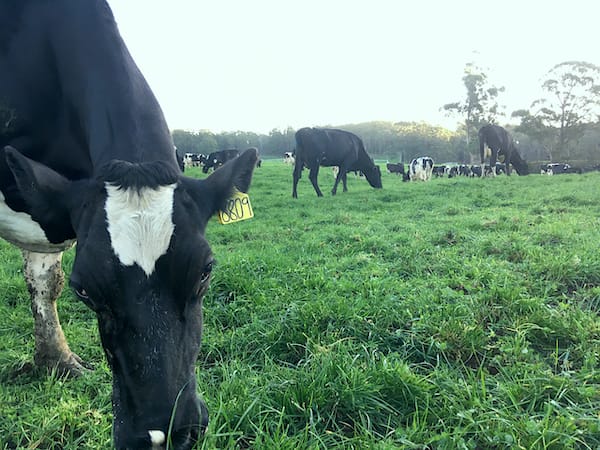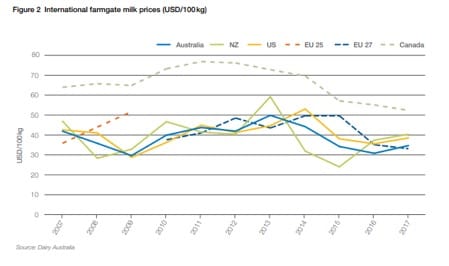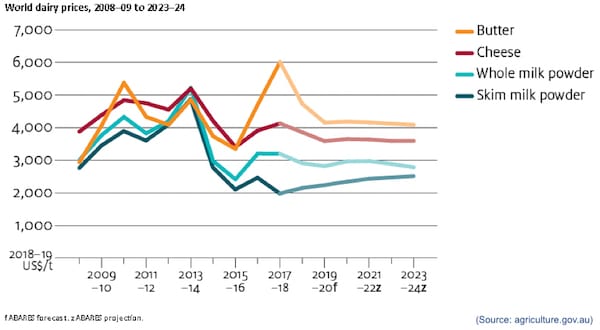Should we still encourage people to start a dairy farm in Australia?
Or, do the problems of dairy farming that dairy farmers face in Australia outweigh the benefits that they gain?
Even though dairy farming has its challenges and problems, ranging from mild to severe ones, so do many other fields and businesses.
Forever an optimist, abiding by the glass of milk half full principle, the answer should always be – yes, you should start a dairy farm in Australia.
However, you should be prepared to handle and face a series of dairy farming issues that dairy farming in Australia bring in the life of dairy farming.
Don’t be too concerned, dairy farming has its share of benefits and positive aspects and the problems – can be well managed. And in time, hopefully – solved with the Australian Dairy Plan and other plans and implemented processes in Australia and worldwide.
Let’s run you through the main dairy farming problems in Australia:
1. Processor Vs Farmer Power
2. From $1 to $1.10
3. Australia dairy farm - dependency on global trends for exports
4. Drought
5. Lack of pasture management

1. Processors Vs Farmer Power
As you might know, in Australia – dairy farmers sell their milk to processors, who then are in charge of placing their milk from cows on the market. However, dairy farmers have very little power over bargaining when selling their product.
Why? Because milk has a short-life and is hard to differentiate it from other same-animal milk.
What happens is that processors make short-term contracts with dairy farmers – and leave an open clause where they can modify and enforce the price the farm-gate milk price they pay farmers. They can adjust the price even after the contract is signed.
This clause gives most of the control and power to processors and offers little to dairy farmers. More than this, it leaves all the risks to fall upon the farmers instead of the processors, supermarket chains or other dairy producers.

This chart is from 2018 released by the Australian Dairy Industry showing the average farm-gate price in dollars that dairy farmers get. It shows the difference between Australia, New Zealand, the U.S., Europe and Canada.
According to our beliefs, and the statement from the Farmer Power, dairy farmers, should receive around 50c or more per litre to have a reasonable return on investment and enough to not only cover their dairy farming expenses. Or a price closer to the farm-gate milk prices that Canadian dairy farmers receive.
Processors blamed the price of $1 per litre for not paying farmers more as the farm-gate price on supermarkets.
However, they pay the same price for milk, respectively, as the milk is packaged in private label or branded products.
On a positive note, this one issue from the dairy farming issues existing in Australia is being fought for by farmers, Australian dairy farm organizations and the Australian Dairy Plan (final draft to be released end of November 2019).
One of the common themes in the Australian Dairy Plan is:
New measures to increase transparency and help manage market risk including the establishment of a functioning milk price market and new risk measures backed by government legislation.
Another positive note is the intention set by the supermarket chain Coles – to buy milk directly from farmers, bypassing processors. Their aim is not only set for their inhouse-branded milk but other dairy products as well.
Dairy farmers are invited to send their expressions of wanting to supply Coles with milk. Coles declared this intent in June of this year – 2019, but it hasn’t yet been put into practice.
2. From $1 to $1.10
Up until last year, in 2018, there was the issue of the supermarkets such as Coles, Woolworths and Aldi selling milk at the fixed price of $1.
After many pressures from dairy farmers and dairy farmers organizations, the giant supermarket Woolworths finally caved in February and agreed to stop selling milk for $1 and have increased it to $1.10.
The other two giant supermarkets Coles and Aldi followed suit in March of this year.
This slight $0.10 increase in their selling price of milk supposedly puts 0.06 cents in the pockets of dairy farmers for each litre of milk, according to the Northern Daily Dealer.
Although this is a sure win (albeit a small) for dairy farming and dairy farmers, it is far from being the change in profit that the dairy farming industry in Australia needs.
An even more substantial increase in private label milk and bypassing processors would mean a more significant increase in profit for dairy farmers - who could make a fairer and much higher profit out selling their milk.
3. Australia dairy farm - dependency on global trends for exports
Australia is a rather large exporter of milk globally. According to the website of the government of Australian agriculture – Australia exports around 36% of its milk all over the world.
In 2018-19, New Zealand and the U.S. managed to produce and export a higher export than Australia putting pressure on commodity prices for Australia.

What this means is that Australia, like other countries, depends on commodity prices enforced by importing countries. The prices fluctuate depending on other export dairy products coming from different countries such as India, The U.S. or New Zealand.
Even though dairy farming in Australia has gained profit from the high demand for dairy products – especially milk powder by China, it was also exposed to risk and lost gains when Russian sanctions were applied.
This makes Australia and Australian dairy farmers, like many other countries, vulnerable and dependent on factors that are outside of their control and not their fault.
The positive note is that at times, the market conditions can be more than favourable to dairy farmers leading to an increase in prices when it comes to exporting their milk.
However, much more regulated and fixed prices for global exporting – would mean a more stable and consistent profit for an Australian dairy farm.
4. Drought
In many parts of Australia, drought can be quite significant – in Victoria, Queensland, New South Wales and South and Western parts of the country.
What the drought brings is low production of fodder and feed-grains. With the low production of feed for animals, it means a high increase in prices – which only takes more money out of dairy farmers who are already struggling to gain profits.
Unfortunately, drought is a hard-natural phenomenon to fight. Water becomes a pricy commodity in drought scenarios. In an article on abc.net.au – farmers are saying a megalitre of water has reached $800 – more than many dairy farms and farmers can afford, outweighing any of their profits.

What’s needed is a complex reform in how “state and federal authorities manage water resources” according to abc.net.au.
Such reform can help dairy farmers feel more secure and stable for their animals' feed – be it pasture or fodder.
Considering the severity and consistency of drought issues in Australia, as well as all the other factors that are negatively impacting dairy farmers – such reform is mandatory for milk production and dairy production to survive in Australia.
5. Lack of pasture management
Using mainly pasture to feed cattle, instead of feedstuff, is a sure win for profitability. One study has proven that results for pasture-based production show higher net return over operating cost.
A lack of pasture management can mean significantly lower profits to dairy farmers. A dairy farm that uses pasture management is a farm that struggles less and earns more.
Not only according to us but to the Food and Agricultural Organization of the United Nations who say,
Good pasture management is one of the most important aspects of successful dairy production.
Many dairy farmers are doing this intuitively, sensing the importance of managing their pasture to improve the feed quality of their animals.
When you use pasture management, you rest assured that your pasture is well-maintained, healthy, and there is also plenty of pasture for your cows.
Until recently, dairy farmers have been using paper and pen to manage their pasture. Now, we have online remote pasture measurement tools or dairy farming software that makes it easier for you, as a dairy farmer, to get pasture measurements and make informed decisions where to graze your cattle. — removing one of the dairy farming issues in Australia.
We have developed Pasture.io – which uses NDVI, latest satellite technology imagery, weather data and farm records to measure your pasture from space accurately. No need to do time and money costing manual labour!
On top of remote pasture measurements, you also receive a very intuitive and easy-to-use farming platform to store digital farm paddock records of all kinds – from grazing, fertilizing, spraying, harvesting and planting information.
I hope the main problems of dairy farming in Australia haven’t scared you off from either – starting a dairy farm, continuing with your own dairy farm or using remote pasture management.
Even though the future of dairy farming seems uncertain – I am sure that it is not. Before things get better, they usually get worse – and it seems to be that way at the moment.
There are constant fights and improvements every year – and hope. Especially with the Australian Dairy Plan set in motion and supermarket chains bypassing processors and selling their private label milk at a higher price.
Find out even more information about how pasture utilisation is a key driver of farm profitability by reading another one of our blog posts. Or, sign up to a free plan today!
Happy farming!
- The Dedicated Team of Pasture.io, 2019-10-02